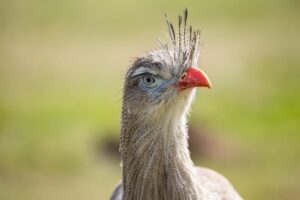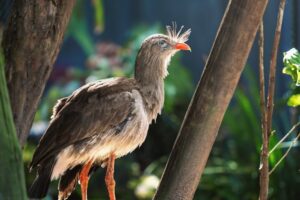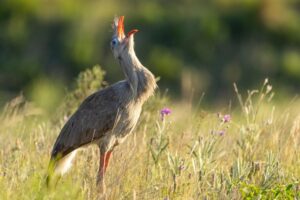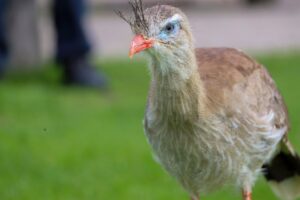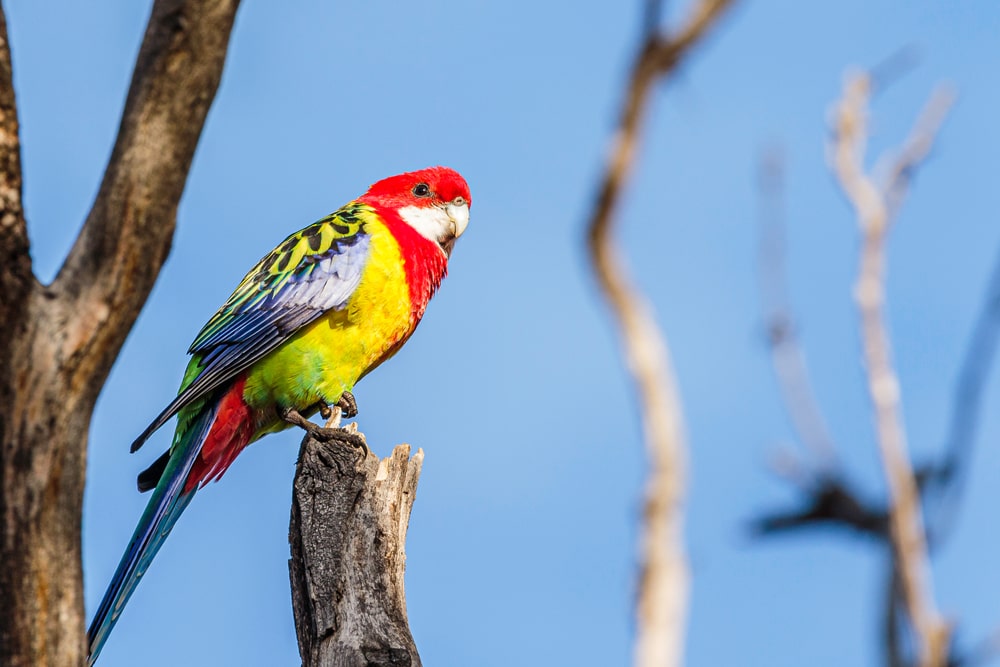Seriema bird, Red-legged seriema Appearance, Diet & Facts
These fantastic birds are certainly some of my more beloved animals. Seriemas have a similar appearance to African secretary birds with their long legs and sometimes fancy head feathers, however they’re not at all closely related. Seriemas were originally classified in the crane family, however new evidence has placed them as potentially more closely related to falcons.
Seriema bird
Like a bird of prey, seriemas have a hooked beak. This is used for catching and tearing apart food. Their long legs are equipped with a retractable claw they use to hold prey in place while they eat, think along the lines of the velociraptors from the Jurassic Park movies. In fact, seriemas are believed to be descendants of terror birds: gigantic, carnivorous birds that once roamed South America. This is also where seriemas are from; they range throughout eastern and central South America.
There are two living seriemas species:
- The red legged seriema
- The black legged seriema
Although their leg color is likely enough to help tell them apart for most folks, the red legged species also sports a giant crest of head feathers that’s nowhere near as prominent in the black legged species.
Seriema Appearance
Seriemas are brownish gray in color, sometimes sporting dark bands across their wings. This is especially true of juveniles. They’re darker along their back and lighter along their belly. Male and female seriemas appear similar and they both sport something most birds don’t have: eyelashes! They have short, rounded wings that often end in white tips, although these are rarely seen because these birds rarely fly.
Seriemas much prefer spending their days on the ground. Their long legs and short toes help them move quickly, especially in short bursts where they can reach speeds well over 15 miles per hour (25 km/h)! When threatened, they would much rather run away than take to the skies, so they rarely do. They do roost at night however, flying to the tops of trees away from nocturnal predators.
Red-legged seriema Call
Red legged seriemas prefer open habitats with bushes, small trees, and even termite mounds they can use for perching throughout the day. Black legged seriemas prefer slightly denser vegetation and are more common along forest edges. When perched, these birds, males and females alike, sing. Their song is described as similar to a yapping puppy. Here’s an example: (seriema call). What do you think? These birds sing to communicate with their partner, offspring, or intruders who aren’t welcome on their territory.
Seriema Life Cycle
These birds travel alone, in pairs, or small family groups. Intruders are met with aggressive displays and even kicks with their long legs! When a male bird is really interested in his female, he’ll display for her and bring her food, she’ll reciprocate if she’s into him. They’ll mate during the spring and work together to build a nest. A seriema nest is made of twigs, mud, and anything else sturdy in the lower branches of a tree
The parents don’t really fly into their nest but simply hop up the branches until they’re inside. Both parents alternate incubating the eggs for just under a month, and then the chicks only stay for two weeks before venturing out with Mom and Dad. There are two eggs per nest on average. It takes about four or five months for the chicks to reach adult size, which can be up to two feet (61 cm) tall, however they typically don’t breed until after they’re a year old.
Seriema Diet & Threats
Seriemas may benefit from agricultural development as this creates more open space for them to roam. They are also often associated with cow and horse pastures where these ungulates’ feces attract seriema prey. These birds eat beetles, grasshoppers, frogs, lizards, snakes and more. In fact, they’re sometimes kept by humans as snake hunters and alarm systems, using their call to warn of potential threats. Seriemas can be brutal while they eat, stomping on their prey with their tough feet or smacking their prey against the ground or rocks to make it easier to swallow whole.

Although they’re not immune to snake venom, seriemas don’t differentiate between venomous and nonvenomous snakes: they’ll eat both! It’s believed their long legs help keep them safer from venomous snake bites, however, they can still succumb if they’re not careful! If they can avoid this fate, seriemas may live to be two decades old.
Reference: https://www.youtube.com/@AnimalFactFiles
